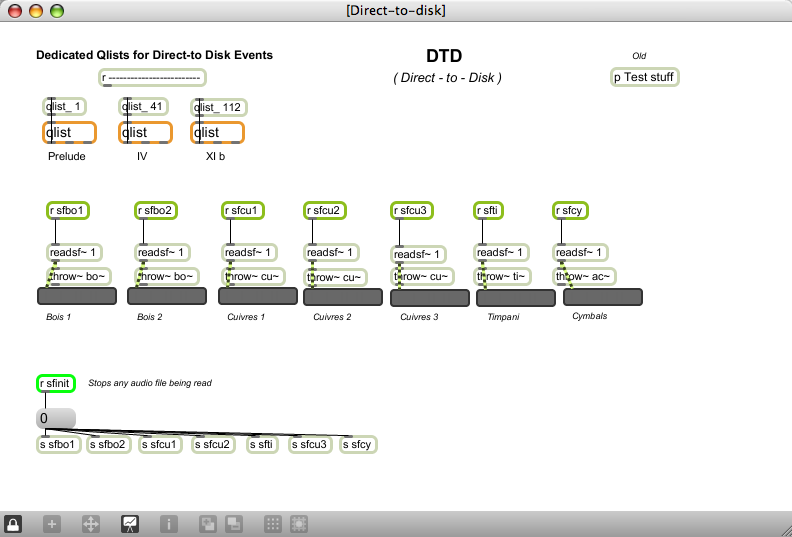Table of contents
Documentation date: 8 juin 2009
Version state
Valid
Validation date: 3 mai 2018
Version documentalist
- laurenzi (Carlo.Laurenzi@ircam.fr)
Version realisation
- Serge Lemouton (Computer Music Designer)
- Carlo Laurenzi (Computer Music Designer)
Version length
1 h 41 mnUpgrade Motivation
This version of "K..." is a Max Msp 5 upgrade of the original 2001 JMax patch.
The Opéra was premiered at the Opéra Bastille in Paris in 2001, then played again, still at Bastille, in 2003. At the time, two powerful SGI (Silicon Graphics) computers were needed, while today a single MacBookPro 2.33 Ghz can run the entire Max 5 patch.
Comment
The electronic equipment list has also been updated to newer technologies.
Other version(s)
Detailed staff
- solistes : 2 sopranos solo, mezzo-soprano solo, 5 ténors solo, 4 barytons solo, basse solo
- 3 flûtes (aussi 1 flûte piccolo), 3 hautbois (aussi 1 cor anglais), 3 clarinettes (aussi 1 petite clarinette, 1 clarinette basse), 3 bassons (aussi 1 contrebasson), 4 cors, 4 trompettes (aussi 1 bugle), 3 trombones, tuba, 3 percussionnistes, 4 timbales, 2 harpes, piano (aussi clavier électronique/MIDI/synthétiseur), célesta, 14 violons, 12 violons II, 10 altos, 8 violoncelles, 6 contrebasses
Electronic equipment list
Computer Music Equipment
-
1 MacBook Pro - Apple Laptops
(Apple)
Minimum Requirements: Core 2 duo 2.33Ghz, 2 Gb Ram, HD 7200 rpm -
1 network - Network/Communication
Fiber Optic System, to pass midi data from the midi keyboard in the orchestra pit to the Fireface 800 soundcard -
1 Max/MSP - Max
(Cycling74)
version 5 -
1 Fireface 800 - Sound Board
(RME)
-
2 KX 88 - MIDI Keyboard
(Yamaha)
Midi Keyboard -
1 BCF 2000 - MIDI Mixer
(Behringer)
Midi Mixer -
2 Studio +2 - MIDI Interfaces
(Opcode)
Midi to Optical translator -
2 Booster - Booster
Midi Booster
Audio Equipment
-
4 Dynamic microphone - Dynamic Microphones
4 Condenser microphones -
3 DPA 4065 - Condenser Microphones
(DPA)
Microphone for the 3 main actors onstage -
1 POWERPLAY PRO-XL HA4700 - Headphone Amplifier
(Behringer)
-
16 Loudspeaker - Loudspeakers
16 Channels loudspeakers system -
1 Loudspeaker - Loudspeakers
2 loudspeakers (monitors) for the keyboard player and orchestra (in the orchestra pit) -
1 DA-16X - Digital Converters
(Apogee)
Digital to Analog converters (16 channels) -
1 DM2000 - Digital Mixers
(Yamaha)
With 2 ADAT cards (+ 16 channels digital inputs / outputs) -
1 C20 - Effects Processor
(Yamaha)
Digital Crossover -
8 DEQ5 - Equalizers
(Yamaha)
Graphic / Parametric 30 band Stereo output Equalizer
Work related information
Premiere
- 7 mars 2001, Paris, Opéra National de Paris
Publisher :
- Durand
Realisation
- Serge Lemouton
Work length
- 1 h 20 mn
Useful links on Brahms
- K... opéra en douze scènes, pour voix solistes, orchestre et électronique en temps réel (2000-2001), 1h20mn
- Philippe Manoury
| File | Author(s) | Comment | |
|---|---|---|---|
| Download [189,2 Mio] | Patch K-MAX5.dmg | ||
| Download [337,3 Mio] | Recording(s) K Prologue - 8 piste.dmg | Prologue - 8 tracks | |
| Download [1,9 Gio] | Recording(s) P Manoury - K - 2009 enregistrements.dmg | recording of Prologue and Scene 9 (electronics only) |
Instructions
Audio setup
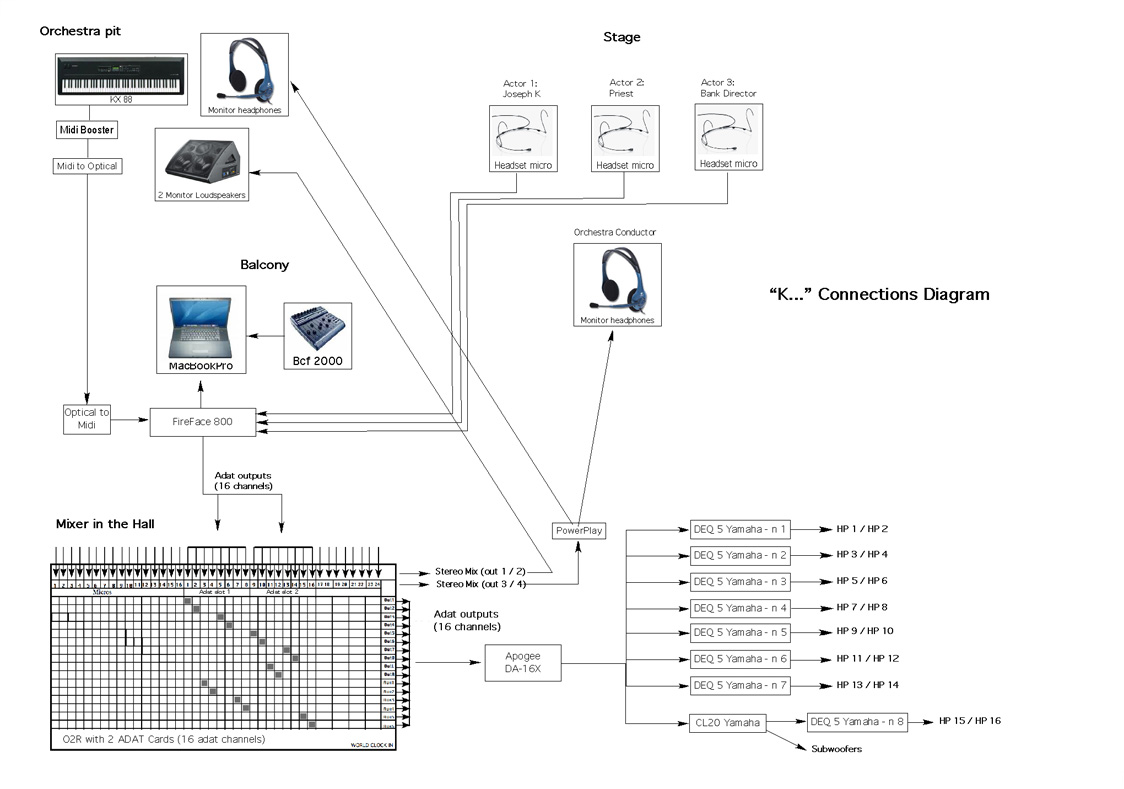
Connections diagram
Loudspeaker setup
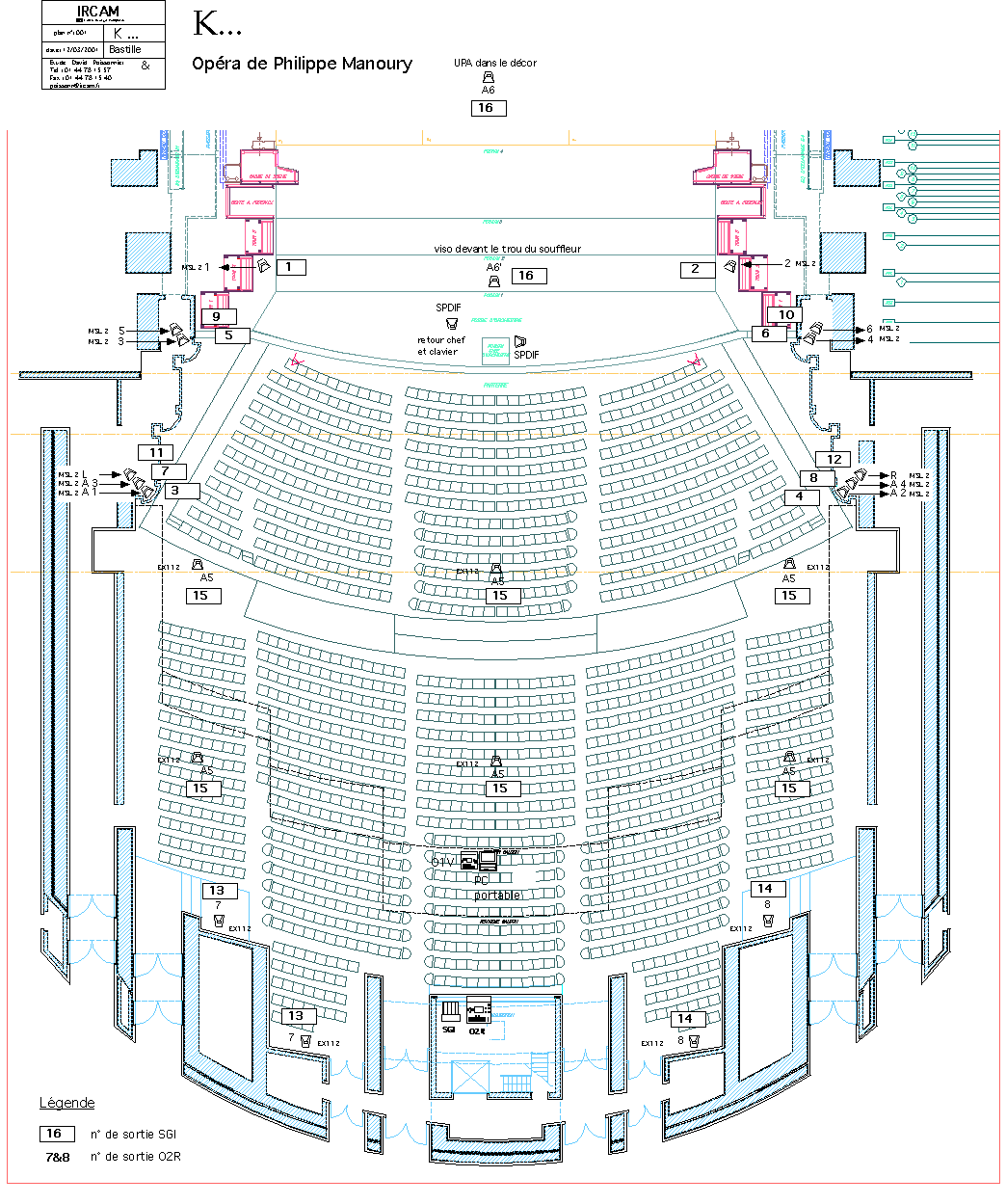
Concert Hall map with Loudspeakers System Setup
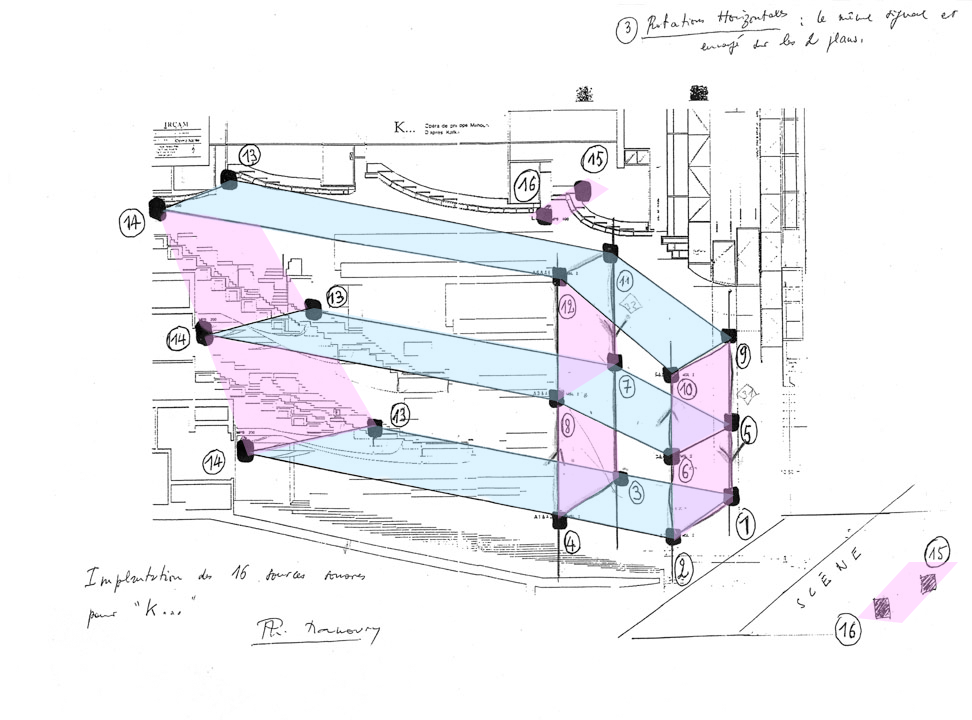
Drawing made by Manoury showing the implementation of the 16 channels sound system
The 16 channels sound system setup is thought as a combination of both three horizontal layers (top, middle, bottom) and three vertical layers (front, middle, back), plus two couples of extensions, towards the ceiling and beyond the front. Three Spat~ (Ircam) modules (together or one by one) are used for spatialization. Furthermore, a panning system is used to perform several kinds of trajectories along the channels system's structure.
Midi setup
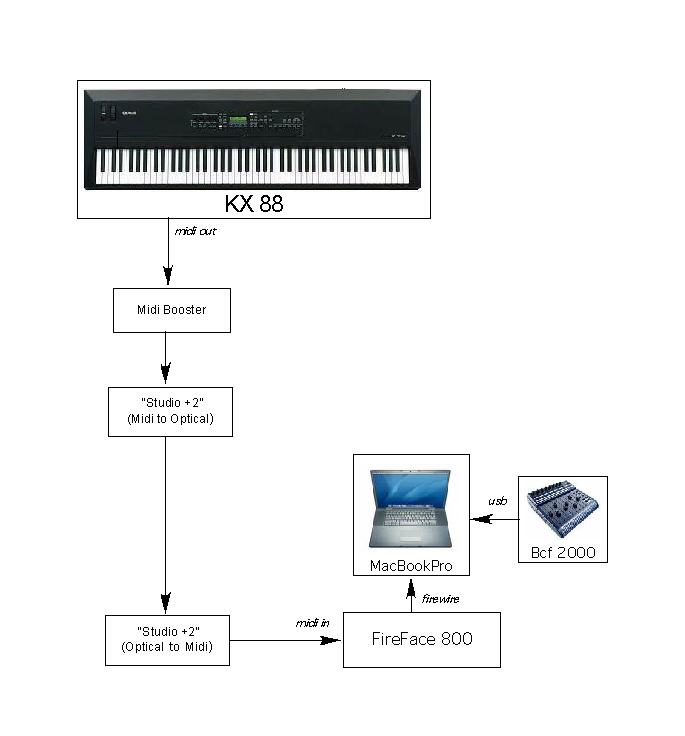
Midi Setup:
Mixer Midi -> assign port "a"
Midi Keyboard -> assign port "b"
Midi Channels:
Mixer midi: ch 1 to 8
Midi Keyboard: ch 9
Software installation
Open Max "File Preferences" panel and add a new path to the folder "K-MAX5".
Look into "Externals" folder. All the externals in that folder must be installed (if they haven't already been installed before).
DSP Status: I/O Vector Size 512 ; Signal Vector Size 64
Max Scheduler "Overdrive" and "Audio Interrupt", must both be turned ON.
--- CPU Load on a MacBookPro 2.33 Ghz, 2Gb ram, 100 Gb Hd 7200 rpm, Osx 10.4.11, Spat 3.4.11 : 48% ---
Initialization routine
Open "Ksyn10.maxpat"
Click on "INIT", then press "0" (initial scene number)
Turn on the DAC.
The first note from the keyboard player's score will trigger the starting of the piece.
Rehearsal
During rehearsals, use the "Goto" automatic system to scroll through the different Events of a single Scene.
To rehearse every Scene from the beginning, first click INIT, then click on the number of the scene to rehearse. The keyboard player will trigger the starting of the scene.
To skip events (one by one), press the space bar.
To reset the patch, click "INIT".
Patch presentation
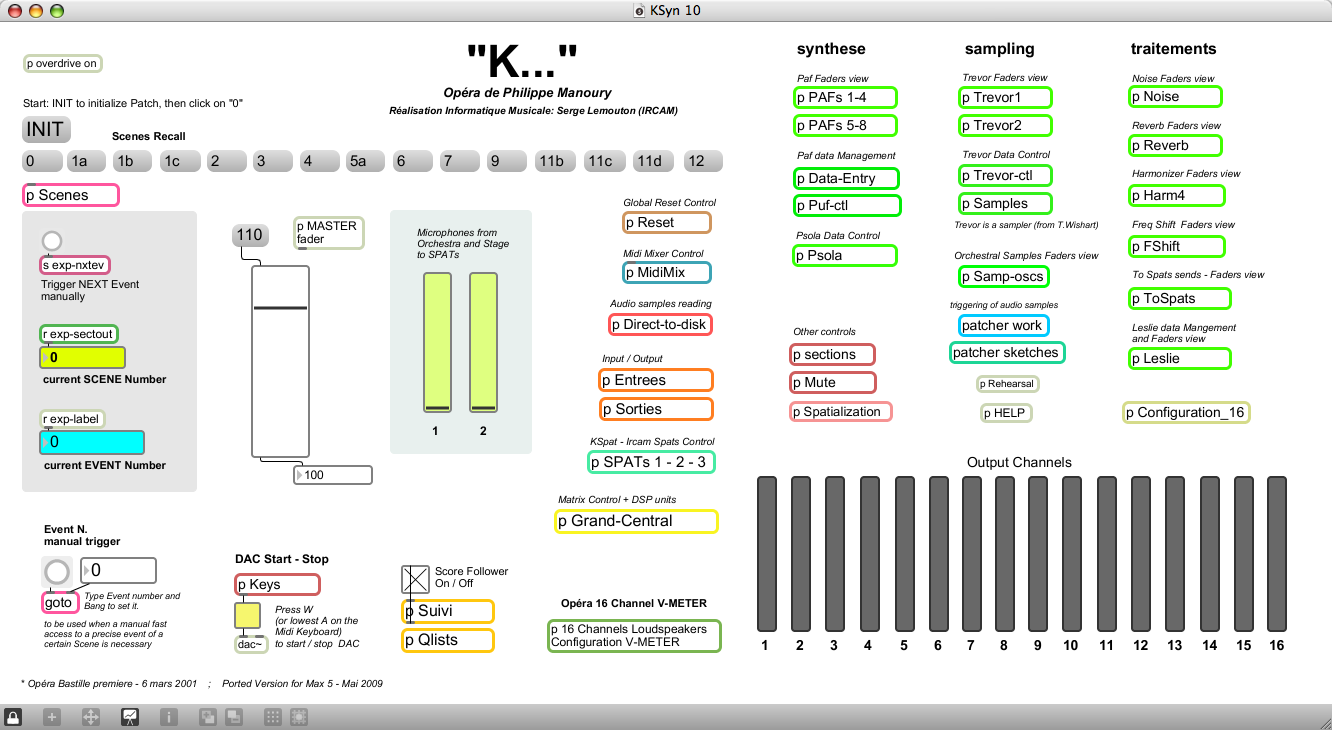
Main Patch screenshot
The left half of the screen contains mainly subpatches dedicated to synthesis computing and audio processing (all the variously coloured boxes), while the right side contains mostly subpatches (green boxes) dedicated to faders views related to synthesis and processings.
Apart the 16 output channel v-meter on the right bottom side, there's another v-meter showing the configuration of the 16 channels system and their related levels (double click on "p 16 Channels Loudpeakers Configuration v-meter" green box).
The Patcher "Work" contains subpatches made by Manoury himself, most of them responsibles for triggering of some soundfiles.
Matrix presentation
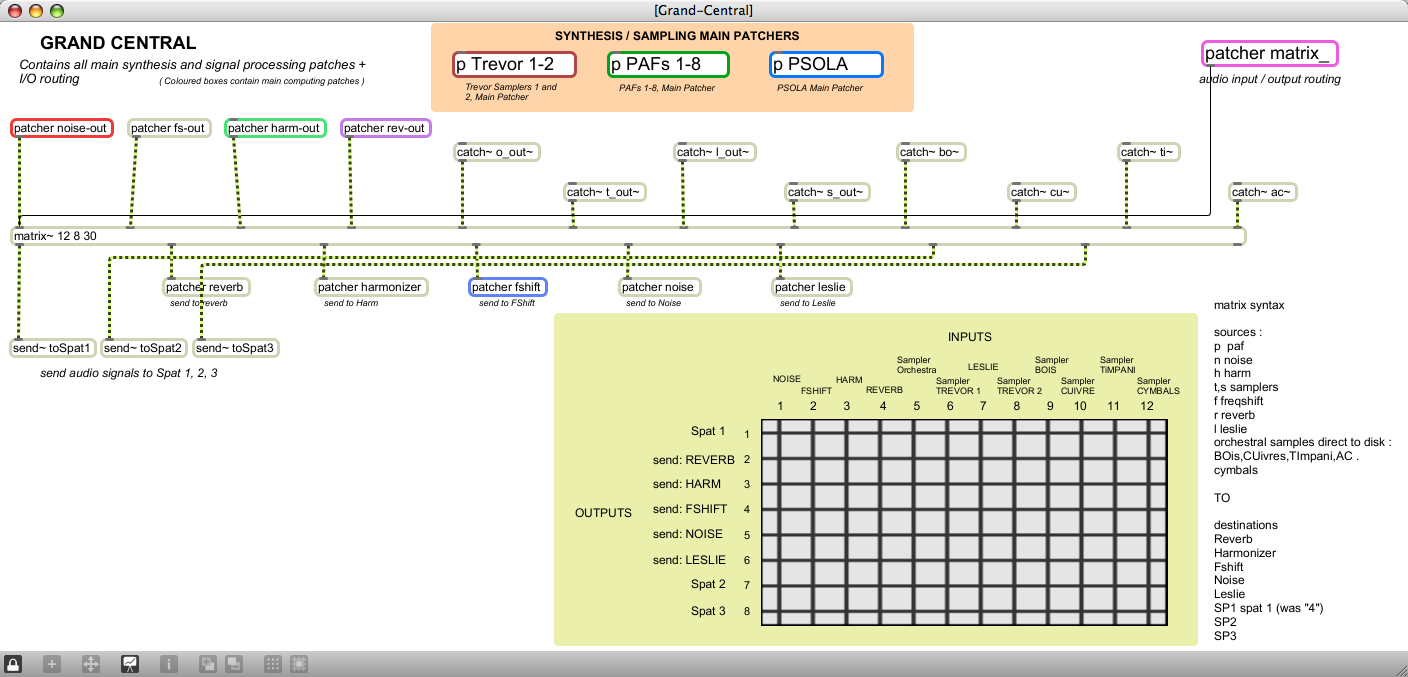
At the top center of the page there's an orange area which contains the main computing patchers for sampling (Trevor 1 and 2) and synthesis (PAFs 1-8 ; Psola).
At the bottom right, the matrix control.
In the middle, the coloured patchers boxes contain the main computing patches for some audio signal treatment (noise, reverb, harmonizer, pitchshifter, leslie).
Midi Mixer view

Opening K main patch launches the "midi mix" window, which shows midi mixer's faders values.
Faders views related to synthesis and processings

Screenshot showing faders view related to the Harmonizers (harmdel~ module).
Inputs and outputs level, sends, transposition frequencies and all other parameters related to the harmonizer are shown.
As a rule of thumb for all these patchers dedicated to faders view, data messages, mostly coming from the qlists, are first received inside "kill.. patcher", then they are sent to main computing patchers, and finally to faders view.
Synthesis and Processing techniques
Synthesis and Signal Processing tecniques used in "K..." are: PAF, PSOLA (for choir synthesis), Sampling, Reverberation, Harmonizer, Delay, Leslie, Non linear distortion, Frequency shift.
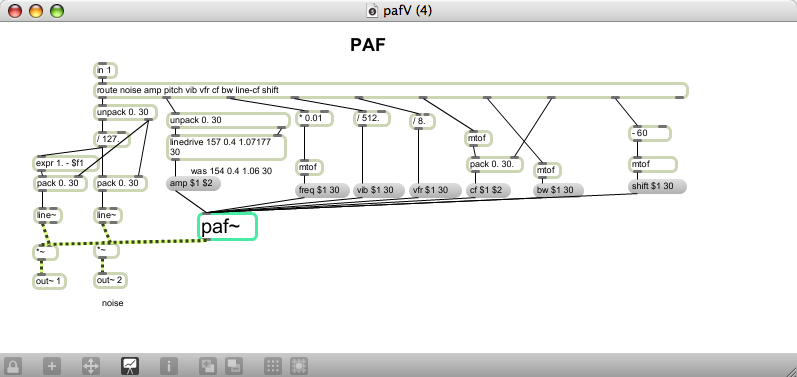
screenshot of a PAF instance
In this version of K, the original Jmax external called "PmPaf~", especially created for Manoury, has been replaced with Miller Puckette's "Paf~" external. Moreover, Paf sounds are here enriched by a nonlinear distorsion process based on a noise sample. (direct and distorted signals are independent)

a screenshot of PSOLA (for choir synthesis) patcher
The original Jmax external for Psola based choir syntesis, "Psgroup~", has been replaced here by "sdif.pagsemble~", which reads 1PSO.sdif description files instead of .mat5 files (matlab).
A sound example of a Choir synthesized with PSOLA (4 groups of 4 singers, synchronized)

screenshot of sampling main patch (Trevor, from Trevor Wishart)
There are 2 sampling engines, Trevor 1 and Trevor 2. Each has a separate fader on the mixer midi.
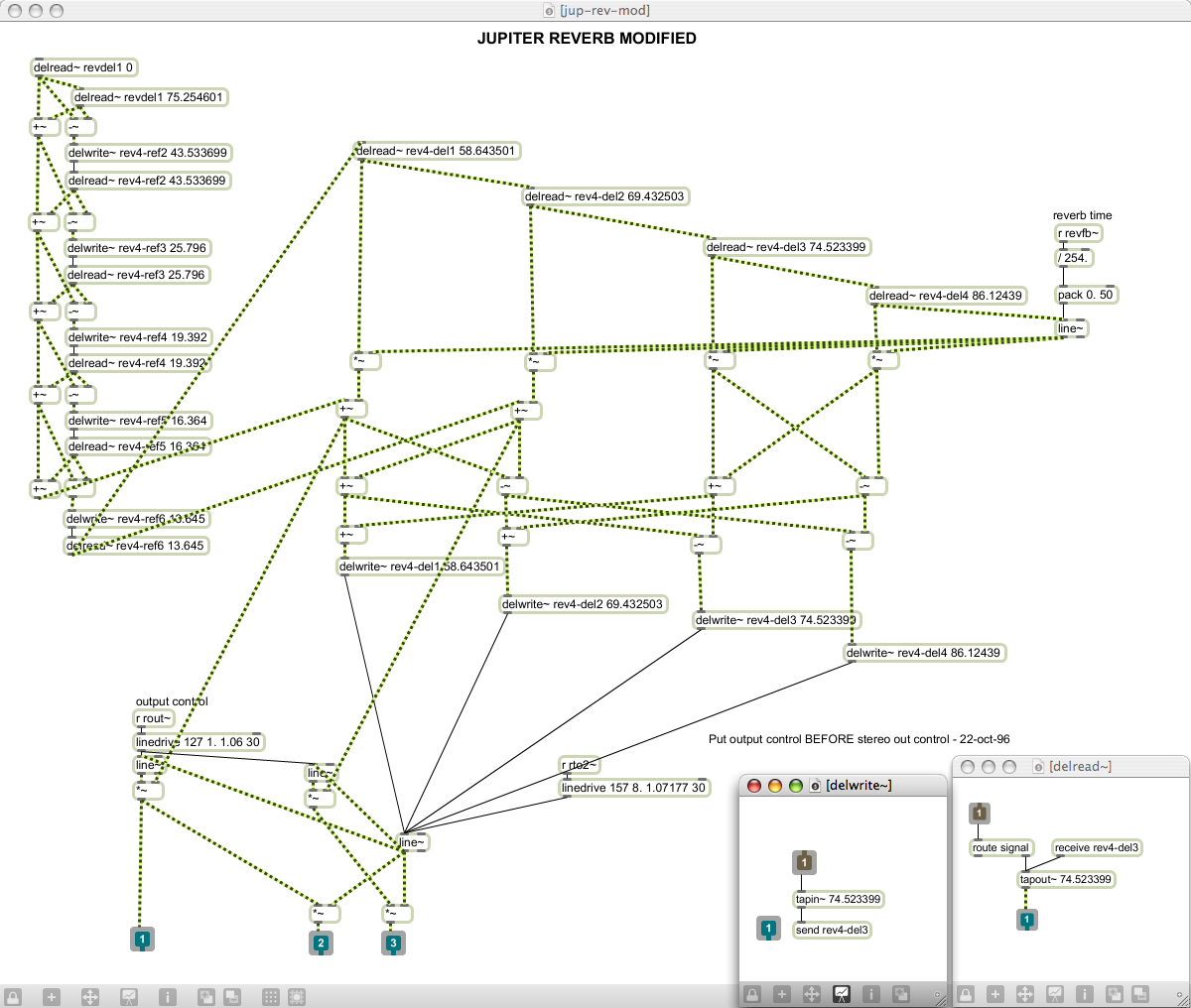
screenshot of the Reverberation algorithm used in "K...". It was previously used in Manoury's piece "Jupiter"
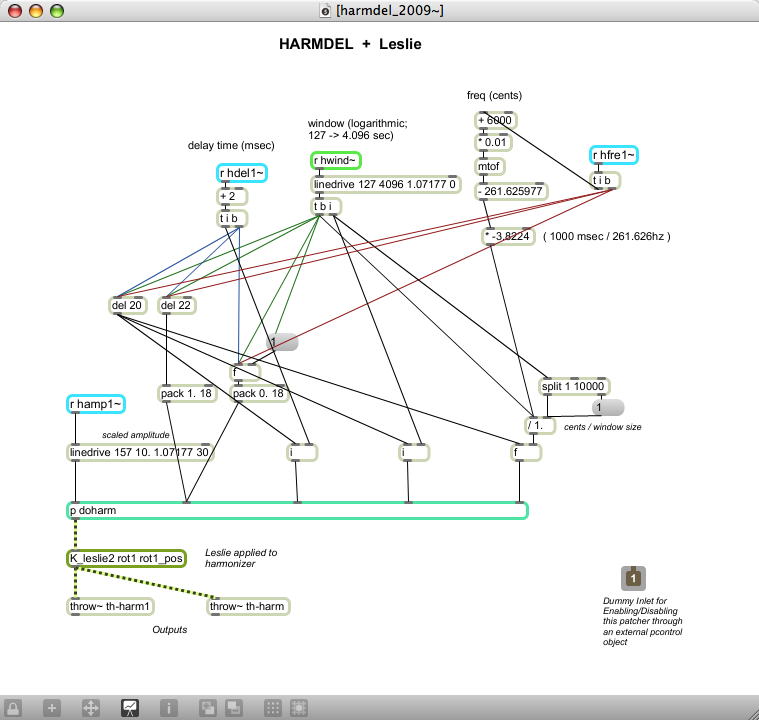
screenshot of Harmonizer main patcher
Delay audio processing is calculated by the harmonizer algorithm itself. A Leslie effect is applied at the end.

screenshot of Leslie effect, with tables and subpatches

sceenshot of non-linear distorsion patch, based on a noise sample
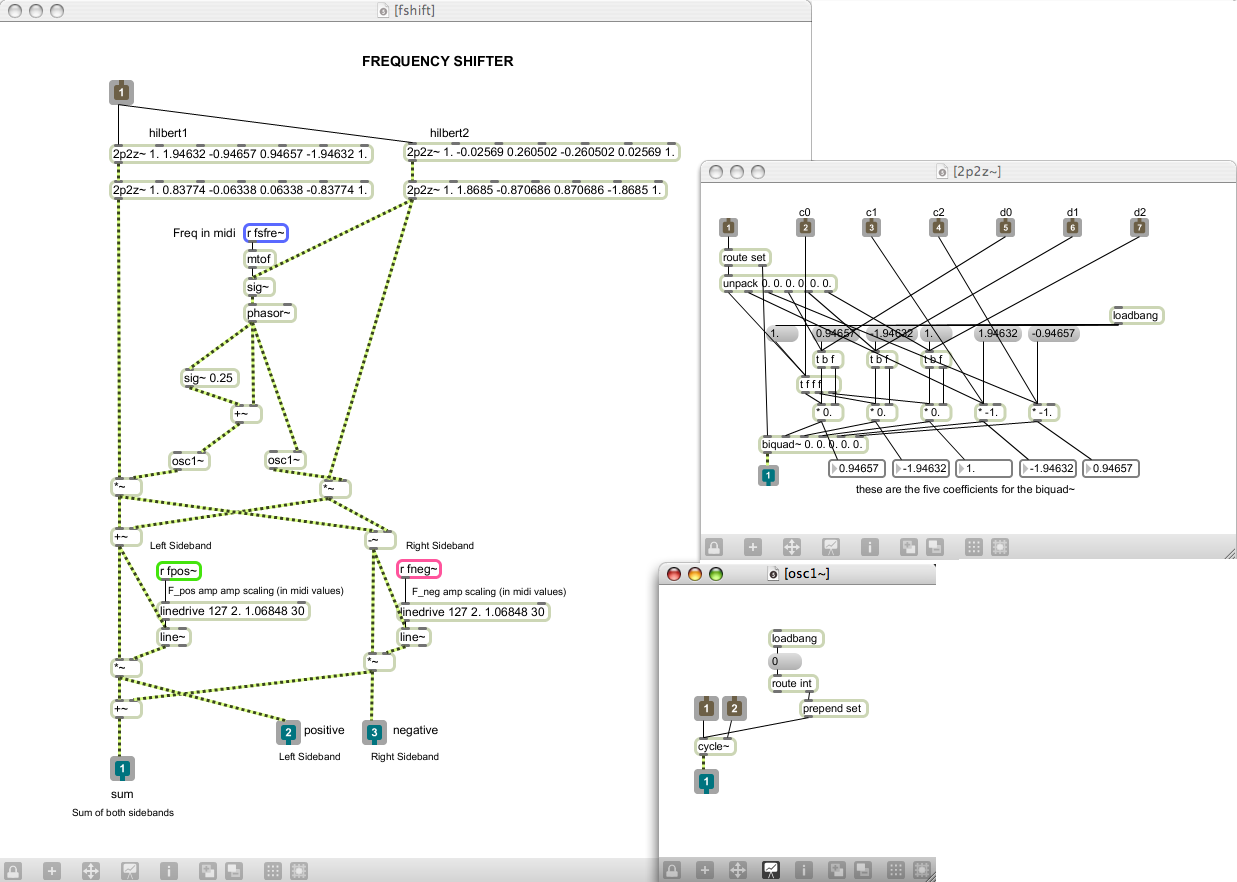
screenshot of Frequency Shifter algorithm
Spatialization using SPAT (IRCAM)
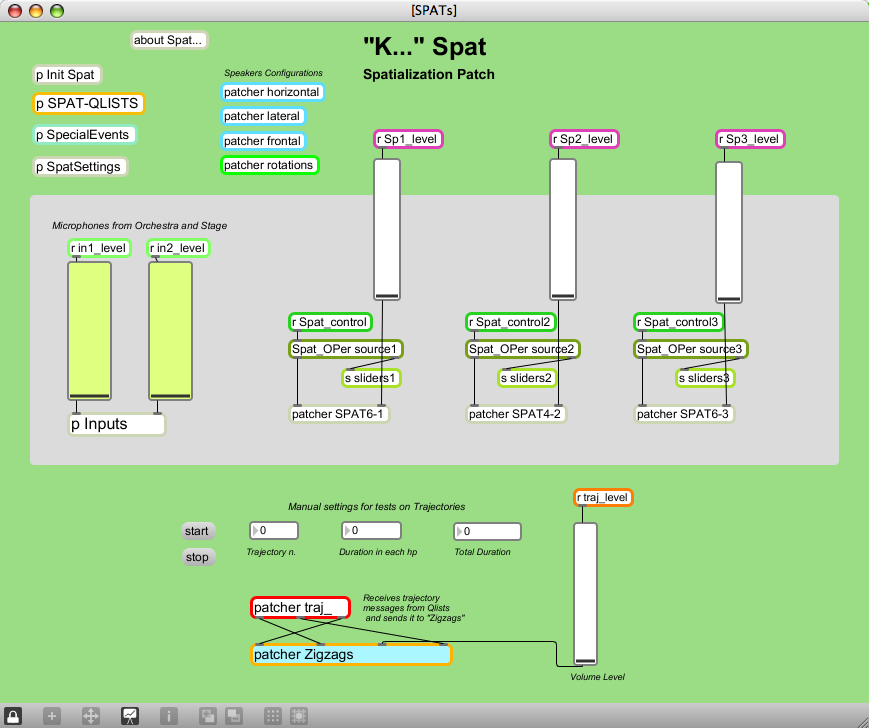
The SPATs patcher for K
In 2001, this SPATs patcher had to be run on another machine (sync'ed with the main computer), because of its high cpu load. On the top half sends values for the three Spats (first has 6 chs, 2nd has 4 chs, third has 6 chs) and for the two stage inputs are shown. The bottom half contains the patchers implemented to perform trajectories along the 16 channels system structure. A Manual choice of trajectory number and partial / total durations is avalable for test purposes.
Spatial Trajectories
During the Opéra, different kinds of spatial trajectories are performed along the 16 channels structure:
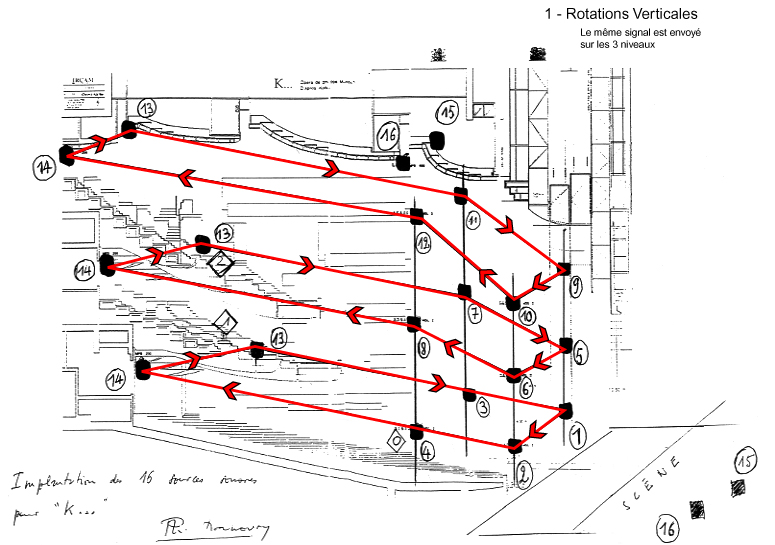
Rotations on the three horizontal planes (top, middle, bottom)

Pingpong movements on the three different planes, at the same time, moving forward and backwards

Rotations on the first two horizontal planes (front, middle)

Trajectory on all planes at the same time, starting from the back to the front, with a final falling down towards the bottom of the stage
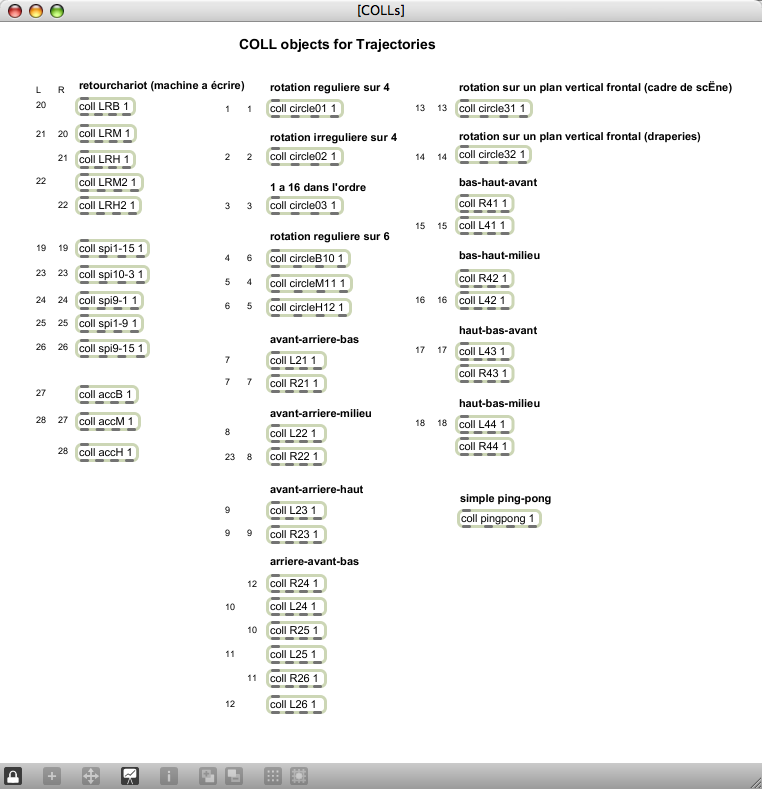
patcher containing the colls describing all the spatial trajectories implemented
Qlists
In "K..." 3 kinds of Qlists are used.
The 1st for all major Events and Scene changes:
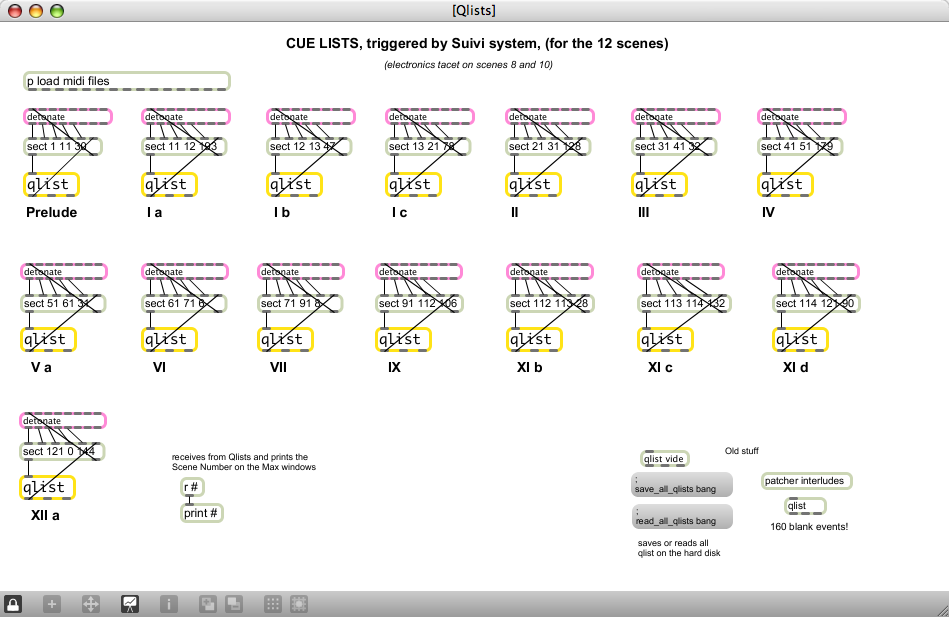
the 2nd for Direct-to-Disk samples triggering:
the 3rd for SPATs and Spatial Trajectories event-related cues triggering:
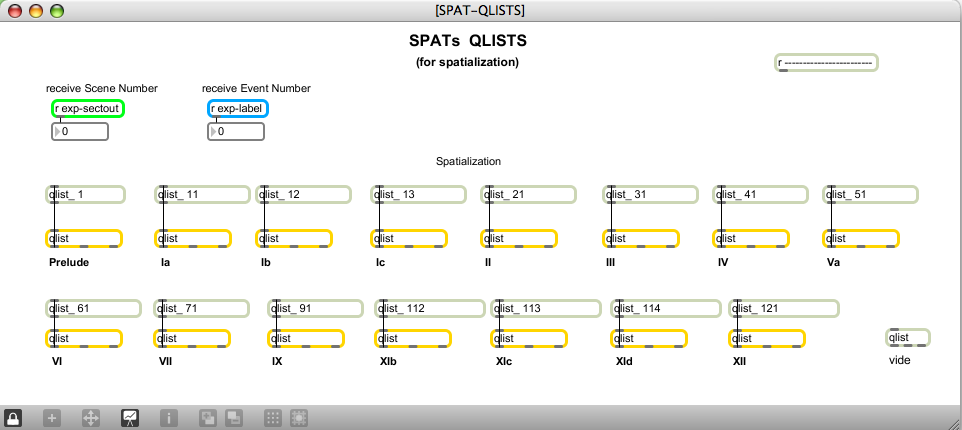
Troubleshooting
If glissandi don't sound right, or they're too slow, check overdrive and audio interrupt on on Max5 "DSP Options" panel.
The PROLOGUE - excerpt from the Opéra
This excerpt shows how PAFs, samplers, harmonizer, delay, leslie, reverb should sound. (Psola synthesis is not used here)
© IRCAM

This documentation is licensed under a Creative Commons Attribution-NonCommercial-NoDerivatives 4.0 International License.
Version documentation creation date: 16 octobre 2013 12:04, update date: 6 mai 2021 15:10
